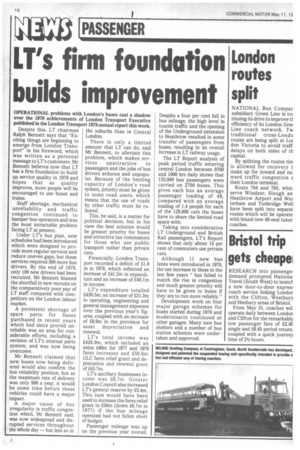LT's firm foundation builds improvement
Page 16

If you've noticed an error in this article please click here to report it so we can fix it.
OPERATIONAL problems with London's buses cast a shadow over the 1978 achievements of London Transport Executive published in the London Transport 1978 annual report this week.
Despite this, LT chairman Ralph Bennett says that "Exciting things are beginning to emerge from London Transport" in his foreword, which was written as a personal message to LT's customers. Mr Bennett believes now that LT has a firm foundation to build up service quality in 1979 and hopes that as quality improves, more people will be encouraged to use buses and trains.
Staff shortage, mechanical unreliability and traffic congestion continued to hamper bus operators and was the most intractable problem facing LT at present.
Under LT's bus plan, new schedules had been introduced which were designed to provide more regular services and reduce uneven gaps, but these services required 500 more bus drivers. By the end of 1978, only 100 new drivers had been recruited. Mr Bennett blamed the shortfall in new recruits on the comparatively poor pay of LT staff compared with competitors on the London labour market.
A persistent shortage of spare parts for buses purchased in recent years which had since proved unreliable was an area for considerable efforts, including a revision of LT's internal parts system, and was now being overcome.
Mr Bennett claimed that new buses now being delivered would also confirm the bus reliability position, but as the maximum rate of delivery was only 500 a year, it would be some time before these vehicles could have a major impact.
A major cause of bus irregularity is traffic congestion which, Mr Bennett said, was now widespread and disrupted services throughout the whole day — but less so in the suburbs than in Central London.
There is only a limited amount that LT can do, said Mr Bennett, to alleviate this problem, which makes ser vices unattractive to passengers and the jobs of bus drivers arduous and unpopular. Because of the limiting capacity of London's road system, priority must be given to some road users, which means that the use of roads by other traffic must be rationed.
This, he said, is a matter for political decision, but in his view the best solution would be greater priority for buses and attractive tax concessions for those who use public transport rather than private cars.
Financially, London Transport recorded a deficit of £1.9 m in 1978, which reflected an increase of £41.2m in expenditure and an increase of £40.1m in income.
LT's expenditure totalled £439.5m, an increase of £31.3m in operating, engineering and general management expenses over the previous year's figures, coupled with an increase of £9.9m in the provision for asset depreciation and renewal.
LT's total income was £428.9m, which included an extra £40m for 1977 and 1978 fares increases and £50.6m GLC fares relief grant and depreciation and renewal grant of £43.7m.
LT's ancillary businesses income was £6.7m. Greater London Council also increased LT's general reserve by £5.4m. This sum would have been used to increase the fares relief grant to £56m (down £6.7m in 1977) if the bus mileage operated had not fallen short of budget.
Passenger mileage was up on the previous year overall. Despite a four per cent fall in bus mileage, the high level in tourist traffic and the opening of the Underground extension to Heathrow resulted in some transfer of passengers from buses, resulting in an overall increase in LT railway usage.
The LT Report analysis of peak period traffic entering central London between 0700 and 1000 hrs daily shows that 133,000 bus passengers were carried on 2700 buses. This gives each bus an average passenger loading of 49, compared with an average loading of 1.4 people for each of the 129,800 cars the buses have to share the limited road space with.
Taking into consideration LT Underground and British Rail passengers, LT's Report shows that only about 15 per cent of commuters use private cars.
Although 11 new bus lanes were introduced in 1978, the net increase in these in the last few years " has failed to match the rise in congestion and much greater priority will have to be given to buses if they are to run more reliably."
Development work on four major garage schemes for buses started during 1978 and modernisatin continued at other garages. Many new bus shelters and a number of bus station schemes were undertaken and approved.




















































































































































































































